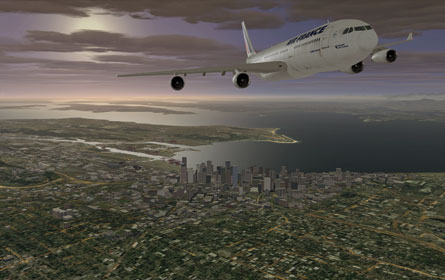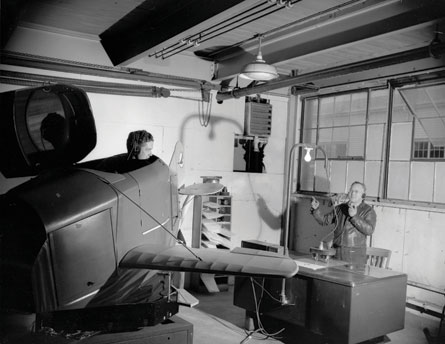Feedback from the field is driving image-generator providers such as CAE and Rockwell Collins to invest considerable research time and money in finding out what it is that makes everyday visual elements believable or, more importantly, not believable.
Phil Perey, CAE's director of technology, says: "In 15-year-old simulators, if you close your eyes, you can believe you're there. But open your eyes [and the visuals] ruin the suspension of disbelief. While in today's simulators, pilots are able to feel like they're there, visually the level of realism remains a journey we are on. We are trying to close the gap so the user can't distinguish between simulation and real life."
The visual details of environmental elements we often take for granted - clouds, in particular - have proved to be much sought after elements of the latest image generators that both CAE and Rockwell Collins are developing and deploying.
 |
|---|
©Rockwell CollinsRockwell Collins' EP-8000 generator is 10 times sharper than its predeccessor |
Projection systems
Compounding the need for better image generators is the new generation of projection systems, which regularly come in the 4-10 megapixel variety, a resolution that is also driving the need for higher-fidelity scene data, particularly around airports.
Collins' EP-8000 image generator, launched in 2009 and recently certificated to Level D by European regulators for Air France's Boeing 777 simulator in Paris, has a 10-times performance improvement over its predecessor, the EP-1000CT (continuous texture) model launched a decade ago, says Dennis Hartley, Collins principal systems engineer for simulation and training.
To simulation experts, that means a large boost in pixel and polygon capacity, but to the user it translates into richer visual immersion. Whereas pilots in an EP-1000CT see scattered clouds "that could never touch each other", those in a simulator with an EP-8000 can fly through and around 3D particle-based volumetric clouds with a variety of densities.
"It is much more realistic," says Hartley. "You can dynamically change the location of the clouds and they can move with the winds." The image generator's algorithms create a seamless sky scene along a route after users input the departure airport and arrival airport weather.
And attention to the scene is more than skin deep. Hartley says customers wanted better-looking wet, puddle or snow-covered runways to improve the simulated effects on aircraft handling and braking. The EP-8000 not only shows puddles, which were previously drawn as darkened sections of tarmac, but shows the reflections in the puddles.
As of 1 April, Collins has shipped seven of the image generators, which are based on customised field-programmable gate arrays (FPGA) that Hartley says do not tend to become obsolete for about 10 years. "Everything is in software now due to FPGA technology," he says. "We can make enhancements without changing any hardware components."
There is an upgrade market potential for as many as 300 earlier-generation EP-1000CTs and EPX-5000s (the military version).
Similarly, CAE has striven to bring out the smallest visual details for its latest image generator - the third-generation Tropos 6000.
"The big step up is around meteorological effects," says CAE's Perey. "We have brought the level of fidelity to a point where we have shadowing and shading on volumetric clouds. The levels of illumination and lighting effects on items on the ground, like snow and sleet, are all one notch up compared with the previous generation of products."
From a training standpoint, Perey says the realism enables aircrew to assess situational awareness properly. "While the flying portion is assisted by autopilots, the pilot is there to assess the environment and make the right judgement calls," he says.
Pilots do that, for instance, by assessing the visuals to determine if a cloud is dangerous. "That call can, ultimately, be a significant factor in a future incident," he adds. "Realism is extremely important."
 |
|---|
©Rockwell CollinsSteven Rockwell Collins EP-8000 simulators have been shipped |
Inside the simulator, a new area where realism is key for CAE is in next-generation air transport system (NextGen) technologies such as automatic dependent surveillance - broadcast. A cockpit display for the Airbus A350, for which CAE is building a full-flight simulator, will require a "realistic representation of airspace", says Perey. "That capability means it is not just a traffic and collision alerting system alert that I receive, but I can monitor and view the other aircraft".
Perey says the project required "a number of improvements" to the simulator in terms of air traffic control modelling and "realistic" flightpaths between airports. "It's part of creating an immersive synthetic environment," he adds.
As good as the visuals have become, Perey admits there is still work to be done. "The difference between the cloud cover and contamination on the runway is night and day [from the previous generation of image generators]," he says. "But there will always remain areas where there are certain angles or views that will need improvement."
The third-generation commercial off-the-shelf-based Tropos 6000 system, a few of which have already been delivered to military customers, represents a 30% improvement in performance over the second-generation system, which came out in 2009, says Perey.
 |
|---|
©Rex FeaturesWe've come a long way |
Source: Flight International
















